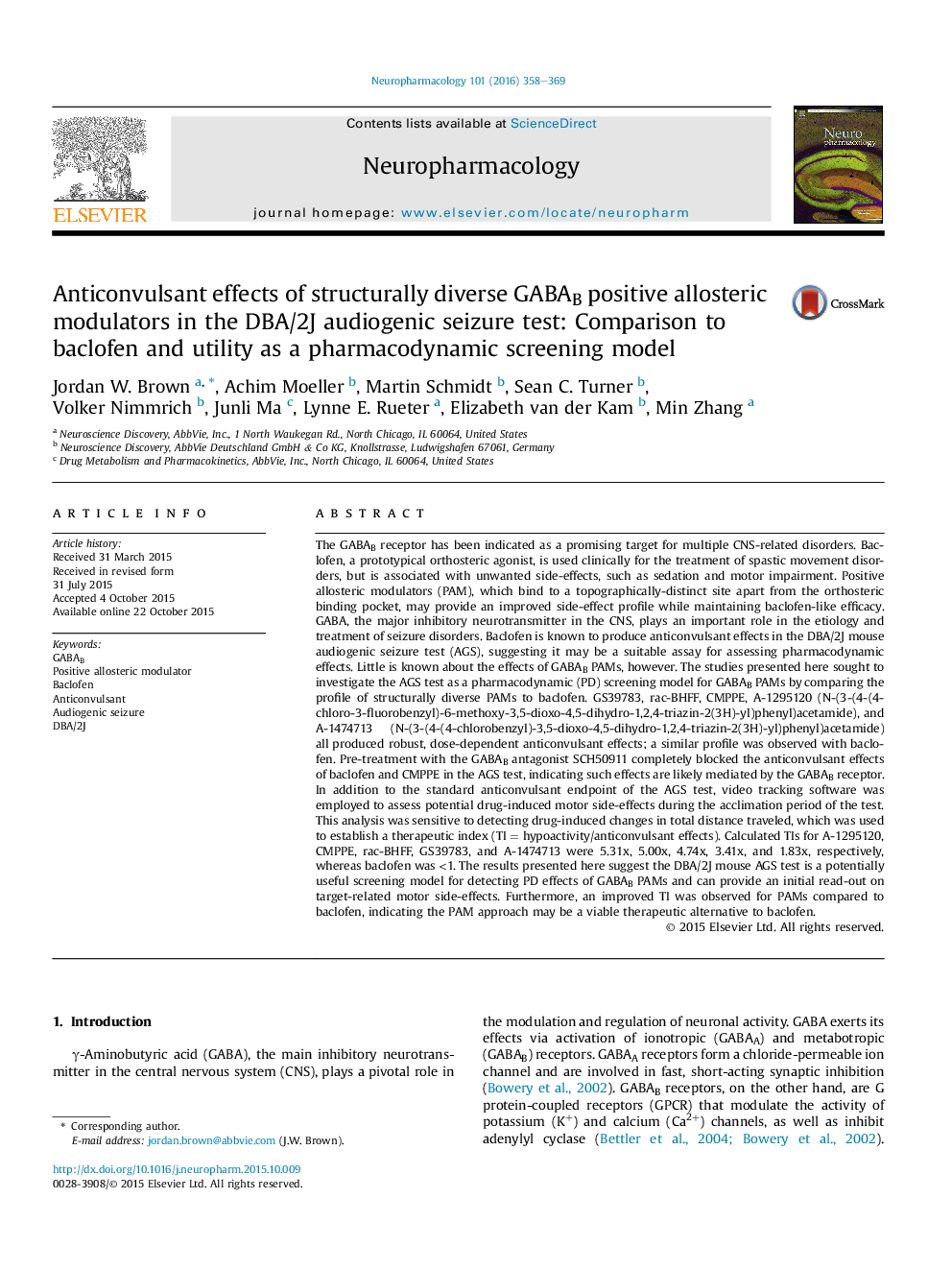| کد مقاله | کد نشریه | سال انتشار | مقاله انگلیسی | نسخه تمام متن |
|---|---|---|---|---|
| 2493127 | 1556614 | 2016 | 12 صفحه PDF | دانلود رایگان |

• Structurally diverse GABAB PAMs were tested in the DBA/2J audiogenic seizure test and compared baclofen.
• Robust dose-dependent anticonvulsant effects were observed with GABAB PAMs, as well as with baclofen.
• Locomotor activity assessed during seizure testing indicated an improved TI with GABAB PAMs compared to baclofen.
• Results support the utility of the DBA/2J audiogenic seizure test as a pharmacodynamic screening model for GABAB PAMs.
The GABAB receptor has been indicated as a promising target for multiple CNS-related disorders. Baclofen, a prototypical orthosteric agonist, is used clinically for the treatment of spastic movement disorders, but is associated with unwanted side-effects, such as sedation and motor impairment. Positive allosteric modulators (PAM), which bind to a topographically-distinct site apart from the orthosteric binding pocket, may provide an improved side-effect profile while maintaining baclofen-like efficacy. GABA, the major inhibitory neurotransmitter in the CNS, plays an important role in the etiology and treatment of seizure disorders. Baclofen is known to produce anticonvulsant effects in the DBA/2J mouse audiogenic seizure test (AGS), suggesting it may be a suitable assay for assessing pharmacodynamic effects. Little is known about the effects of GABAB PAMs, however. The studies presented here sought to investigate the AGS test as a pharmacodynamic (PD) screening model for GABAB PAMs by comparing the profile of structurally diverse PAMs to baclofen. GS39783, rac-BHFF, CMPPE, A-1295120 (N-(3-(4-(4-chloro-3-fluorobenzyl)-6-methoxy-3,5-dioxo-4,5-dihydro-1,2,4-triazin-2(3H)-yl)phenyl)acetamide), and A-1474713 (N-(3-(4-(4-chlorobenzyl)-3,5-dioxo-4,5-dihydro-1,2,4-triazin-2(3H)-yl)phenyl)acetamide) all produced robust, dose-dependent anticonvulsant effects; a similar profile was observed with baclofen. Pre-treatment with the GABAB antagonist SCH50911 completely blocked the anticonvulsant effects of baclofen and CMPPE in the AGS test, indicating such effects are likely mediated by the GABAB receptor. In addition to the standard anticonvulsant endpoint of the AGS test, video tracking software was employed to assess potential drug-induced motor side-effects during the acclimation period of the test. This analysis was sensitive to detecting drug-induced changes in total distance traveled, which was used to establish a therapeutic index (TI = hypoactivity/anticonvulsant effects). Calculated TIs for A-1295120, CMPPE, rac-BHFF, GS39783, and A-1474713 were 5.31x, 5.00x, 4.74x, 3.41x, and 1.83x, respectively, whereas baclofen was <1. The results presented here suggest the DBA/2J mouse AGS test is a potentially useful screening model for detecting PD effects of GABAB PAMs and can provide an initial read-out on target-related motor side-effects. Furthermore, an improved TI was observed for PAMs compared to baclofen, indicating the PAM approach may be a viable therapeutic alternative to baclofen.
Journal: Neuropharmacology - Volume 101, February 2016, Pages 358–369